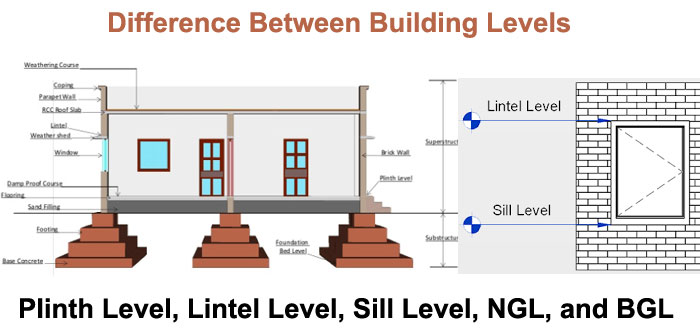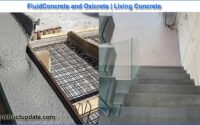Difference Between Plinth Level, Lintel, Sill Level, NGL, and BGL in Building Construction
There are various types of levels in a building. The Autocad drawings contain the detailing of different levels like their dimensions, which makes the understanding process easier for the engineers.
The different types of building levels are as follows:
- Plinth Level
- Sill Level
- Lintel Level
- Natural Ground Level(NGL)
- Building Ground Level(BGL)
Further detailing has been provided below to make a better understanding.
Plinth Level
‘Plinth’ is basically the portion of superstructure located between the finished floor and the surrounding ground. The floor level is usually referred as the ‘plinth level’.
This level primarily works on termination of the access of moisture, excessive dampness, rain/storm water seepage inside the building. Plinth level height ranges usually from 300-450mm. The height reference is taken from the natural ground level and the minimum height of this level is taken 150mm from the road level.
Functions:
Plinth level performs the following functions-
- The whole structure is protected from dampness.
- Stability of the structure is maintained by transferring load to substructure from superstructure.
- Improvement of the aesthetic appearance of the structure.
- This level also elements the differential settlement of foundation to certain level.
Sill Level
‘Sill’ is the base portion of the window made up of masonry elements. The vertical measurement or height between the finished floor level of the building and the base of the window is known as the ‘Sill Level’. This levels are found in windows only.
In living rooms and other rooms, the height of Sill level generally ranges between 600-650mm, whereas in bathroom, a minimum of 1100mm is the height of the level(more due to privacy concerns).
Functions:
This level has some specific functions-
- Prevention of the entry of moisture
- A rigid base is provided to both the window-frame and window as a whole further providing support to the window.
- Also provides a smooth and finished surface to the window.
Absence of Sill can form cracks in the wall due to the load coming on it and also seepage of moisture in the wall may occur.
Lintel Level
The elements located at the top of doors and windows that are made up of Reinforced Cement Concrete(RCC) are termed as ‘Lintel’. Lintels are provided to the doors and windows unlike sills that are used only for windows.
Functions:
Tranfers the load, to the surrounding wall areacoming from the walls above, as the frame of the door is not capable of bearing the load coming from the wall above it.
The preferable Lintel Height as per the building regulations for the residential building is 2.1m and for the commercial building is 2.3m.
Natural Ground Level(NGL)
The level of the ground or the land in its unmodified state is known as ‘Natural Ground Level(NGL)’. The height of this level is generally measured with reference to the Mean-Sea Level (MSL). The measurement is done in its original state without any further modification like cutting or filling.
Building Ground Level(BGL)
The finished floor level inside the building is termed as ‘Building Ground Level (BGL)’. The height usually ranges between 150-450mm from the Natural Ground Level(NGL).
If a building is located in any area which either is sloppy or receives heavy rainfall, the height of BGL may needs to be increased.
Functions:
Prevents or restricts the entry of water inside the building due to rainfall or storm.






